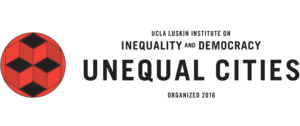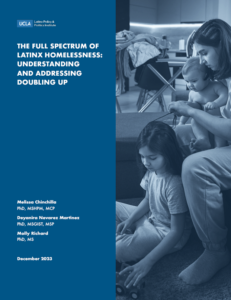Latino Policy & Politics Institute
Co-authored by Melissa Chinchilla, #UnequalCities Network member Deyanira Nevárez Martínez, and Molly Richard
Excerpt: Between 2020 and 2022, the number of Latinx individuals experiencing sheltered or unsheltered homelessness rose nearly 8 percent nationally (HUD 2022). COVID-19 was likely a contributing factor. Latinx1 households disproportionately experienced negative economic and health impacts and challenges accessing emergency resources during the pandemic (Chinchilla, Moses, and Visotzky 2023). Many households were already living on the edge of homelessness and had adapted to Los Angeles’ housing affordability crisis by doubling up in overcrowded, substandard housing. Scholars who have examined “doubled-up homelessness”—the practice of sharing housing because of economic hardship or housing loss—at the national level found that in 2019, Latinxs were nearly three times as likely as non-Latinxs to be doubled-up (Richard et al. 2022).
While scholars have estimated doubled-up homelessness at the national level, few have conducted analyses at the local level. Moreover, homelessness among Latinxs, including the factors that facilitate or impede their access to housing and homeless services, continues to be largely understudied. To address these gaps, we examined doubled-up homelessness in Los Angeles County—home to the largest number of people experiencing unsheltered homelessness nationally and one of the regions with the largest share of Latinx residents—with a focus on estimating the scale and characteristics of those living in doubled-up households. Additionally, we used interviews with homeless service providers and policy advocates to understand how doubled-up homelessness may impact service access for Latinx households.
Download >> The Full Spectrum of Latinx Homelessness: Understanding and Addressing Doubling Up


